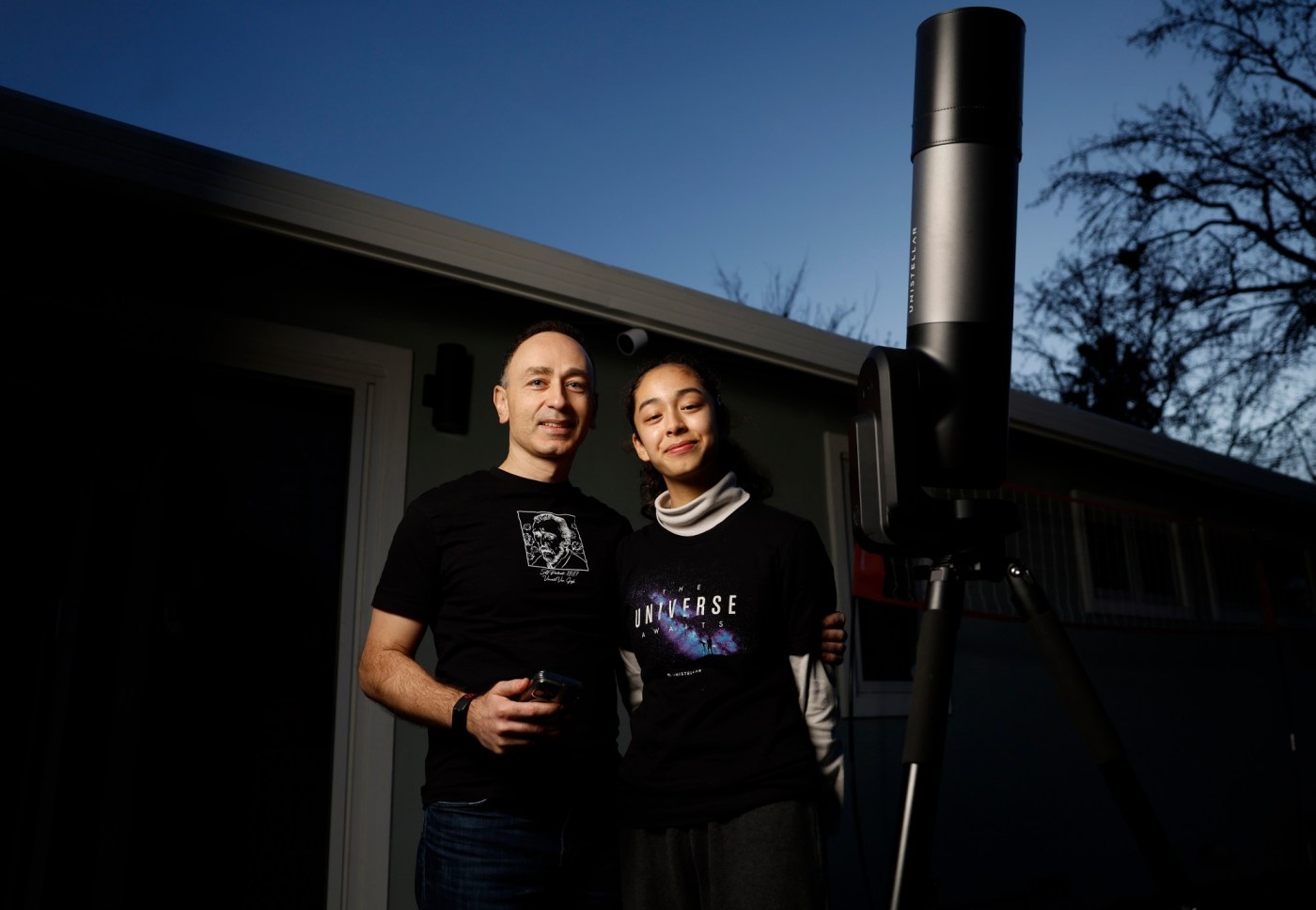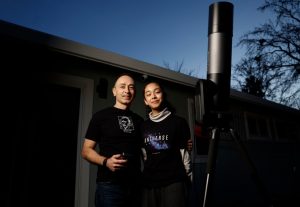
How ‘citizen astronomers’ in Silicon Valley and around the globe helped NASA track a distant Saturn-sized world
Pointing a silver telescope toward the evening sky, Fadi Saibi prepared for a special observation session in the backyard of his Sunnyvale home. It took just a couple of taps to pair his phone with the telescope and lock onto a cosmic object. The target: TOI-4600c, a planet near the constellation of Draco, orbiting a star some 815 light-years from Earth.
“I was concerned because I have some trees in my backyard,” Saibi said. “But after checking, it seemed like there was good visibility.”
By day, Saibi works as the chief technology officer of Artemis Networks, a wireless technology company based in Mountain View. But on the evening of Oct. 16, he indulged a childhood passion for stargazing as part of a widespread research study conducted by amateur astronomers worldwide. The project seeks to understand TOI-4600c and other worlds orbiting distant stars, known as exoplanets. It’s an example of citizen science — collaborations that involve ordinary members of the public in scientific research.
A scientific project like this is not generally why people start watching the stars — but the compelling research has drawn a worldwide network of amateur astronomers like Saibi.
“Sometimes, I long for just spending time looking at the stars, like I used to,” he said.
Fadi Saibi and his daughter Sophie, 14, demonstrate how they set up their Unistellar telescope in their backyard in Sunnyvale, Calif., on Thursday, Jan. 11, 2024. (Nhat V. Meyer/Bay Area News Group)
The project is called UNITE, for the Unistellar Network Investigating TESS Exoplanets. Sponsored by NASA and organized by the SETI Institute in Mountain View, UNITE re-examines exoplanet candidates detected by NASA’s Transiting Exoplanet Survey Satellite (TESS), which has been probing the universe for distant worlds since 2018.
The TESS survey divides the sky into 26 segments, and the satellite observes each every 27 days. Its cameras don’t see exoplanets directly, but instead record the reduction in the amount of light coming from a star as an exoplanet crosses in front of it. This transit results in a dip in the star’s “light curve” — a visual representation of the data TESS receives.
UNITE is a collaboration with the hobby telescope manufacturer Unistellar, allowing anyone who can afford one of the company’s 6-inch smart telescopes — which retail at $4,900 — to jump into cutting-edge science. It operates under a larger exoplanet citizen science program with Unistellar started by Search for Extraterrestrial Intelligence (SETI) Institute scientist Thomas Esposito in 2020.
The main program observes a range of exoplanets — from as large as Jupiter to smaller than Saturn — orbiting stars similar to our sun. Often, these planets are much warmer and orbit closer to their star. Rather than studying these hot, rapidly-orbiting planets, UNITE aims to gather data on rarer worlds that orbit farther out from their parent stars.
“We try to go after something with more than a hundred-day orbit,” Esposito said.
TOI-4600c is similar in size to Saturn, with an orbit that in our solar system would put it between Earth and Mars. Temperatures in its swirling atmosphere are thought to be -110 degrees Fahrenheit, making it just warmer than Jupiter. And like Jupiter and Saturn, it could have moons.
TOI-4600c orbits an orange dwarf star that is slightly smaller and cooler than our sun. Following the detection of an initial transit in 2020, TESS observed a second one 965 days later in 2022. This left researchers with a cosmic conundrum: Could this exoplanet really have such a long orbit, or did TESS simply miss other times it crossed its star while looking at other systems?
Running computer models to simulate the exoplanet’s possible orbital dynamics, graduate student Ismael Mireles and his team at the University of New Mexico calculated that TESS most likely missed one transit. This meant the next one would be observable in the northern hemisphere in the middle of October 2023. UNITE later received a call from NASA’s TESS Follow-Up Observing Program with the mission to further narrow down TOI-4600c’s orbital period, or year.
SETI scientists organized an international session on Oct. 16 and 17 that involved observers from East Asia to North America. All they had to do was set up their smart telescope from their location during the observation window and import the coordinates through the Unistellar app on their phone. Their telescopes would then automatically track the host star as it swept across the night sky, recording the amount of light reaching the telescope and sending the data to computer servers at the SETI Institute.
Six observers in Japan caught the exoplanet’s “ingress,” during which it began crossing its host star. Japanese observers had a slightly difficult time tracking the planet, however, because the target star hung low in the sky, near the horizon.
“To observe at a low altitude, I went to a location with a clear view of the northern sky,” Keiichi Fukui, a retired scientist who worked at the Meteorological Research Institute in Tsukuba, Japan, wrote in an email.
Sophie Saibi, 14, shows off an image her father, Fadi, and her took with the Unistellar telescope of the Trifid Nebula, also known as Messier 20, in his backyard in Sunnyvale, Calif., on Thursday, Jan. 11, 2024. (Nhat V. Meyer/Bay Area News Group)
Related Articles
NASA delays Artemis II and III moon missions to 2025 and 2026
The ashes of a Massachusetts man will be launched into deep space on the Enterprise Flight: ‘He was a big science fiction reader’
Next, three observers across North Asia and Europe caught the exoplanet mid-transit: one in Russia, one in Finland and one in France.
During his observation, Patrice Girard, a retired secondary school teacher in southwest France, set up several extra devices alongside his telescope. “The large screen of my 13″ iPad lets me record photos and videos, and my 13″ MacBook Air lets me chat with other amateur astronomers and check the settings in real time,” Girard wrote in an email.
Finally, about 11 hours after Fukui’s observations, Saibi and four other U.S. citizen scientists caught the exoplanet’s “egress” as it finished its transit across the face of its parent star. The only obstacle these observers encountered was cloudy weather.
Related Articles
NASA delays Artemis II and III moon missions to 2025 and 2026
The ashes of a Massachusetts man will be launched into deep space on the Enterprise Flight: ‘He was a big science fiction reader’
Saibi said that other observers in the Oakland area couldn’t participate due to the settling fog and clouds. “I was very fortunate,” he said. “I set up the telescope shortly after sunset and the sky was still clear.”
Combining the data, UNITE’s lead scientist Lauren Sgro of the SETI Institute produced a comprehensive light curve showcasing every citizen astronomer’s contributions. The global effort in documenting TOI-4600c’s transit will help nail down the exact length of its year, estimated at around 482 days.
“This was a really good transit for the UNITE program because of where our observers are located,” Sgro said. “We have a lot of observers in the U.S. and Japan. That’s where the beginning and end of this transit were visible from.”
Projects like UNITE are valuable in gathering more data on distant worlds, given the costs and logistics of getting time at professional observatories, said Rob Zellem, lead scientist of NASA’s Exoplanet Watch, another citizen science project that allows interested amateur astronomers to generate observational data for distant planetary systems.
“They have over a few thousand Unistellar users across the world, and a few hundred of them are interested in helping out in exoplanet science,” Zellem said. “They bring really big strength in numbers, with telescopes that allow us to get high-quality data.”
For his part, Saibi has relished the opportunity to connect with his 13-year-old daughter, who’s “at an age where she’s learning physics, mechanics, math, trigonometry,” Saibi said. “So by using an optical instrument like that, she’s going to get a more intuitive sense of all those different concepts.”


